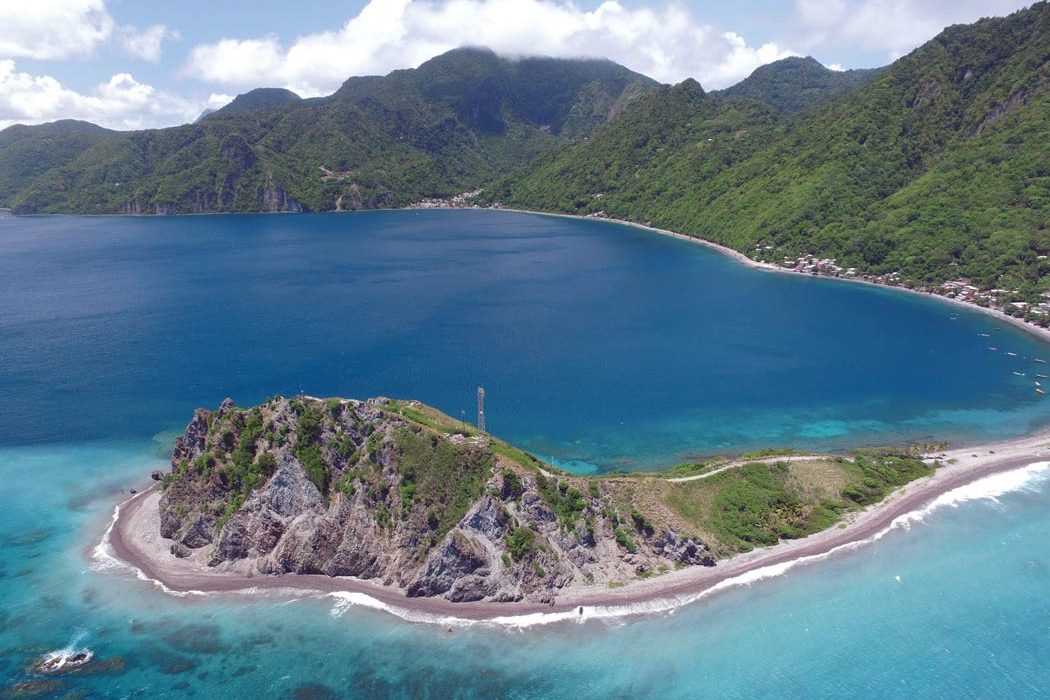If you were asked to close your eyes and imagine what color best describes a “typical” Caribbean island, chances are you’d envision blue, specifically the clear blue ocean waters we divers love so much. The waters off Dominica can be seen in all the blue hues you can dream up, but the island’s color palette is just as famous for the rich shades of green that carpet its volcanic peaks and adorn its tropical rain forests. And its beaches? Most consist of shimmering black sand. Nothing about this place is what you’d consider “typical.” In fact, it’s extraordinary. A paradise for scuba divers, hikers and nature lovers, Dominica is a colorful feast for the eyes and an energizing, 100 percent organic tonic for the soul.
Natural and Cultural History
The Commonwealth of Dominica, known as “The Nature Island of the Caribbean,” is located in the Windward Islands, between the French islands of Guadeloupe and Martinique in the Eastern Caribbean. It should not be confused with the Dominican Republic — a completely different country located 624 miles (1,004 km) to the northwest. The largest and most mountainous of the Windward Islands, Dominica covers over 751 square miles (290 m2), is 29 miles (47 km) long and 16 miles (26 km) at its widest. Much of the island is celebrated as protected National parks and reserves. The 17,000-acre (6,900 ha) Morne Trois Pitons National Park is a UNESCO World Heritage Site featuring several crater lakes and stunning waterfalls. The Northern Forest Reserve is an oceanic rainforest that is home to the rare and exotic Sisserou parrot, Dominica’s national bird, and the Jaco (or Jacquot) parrot, both of which are found nowhere else in the world.
Dominica lays claim to other “found nowhere else in the world” attractions. These include Waitukubuli National Trail (called the WNT), a 114 mile (183 km) hiking trail that extends the length of the island from Scotts Head in the south to Capuchin in the north, and Boiling Lake, one of only two such natural phenomena in the world. It has more volcanoes (a total of nine) than any other island. It also has 360 rivers.
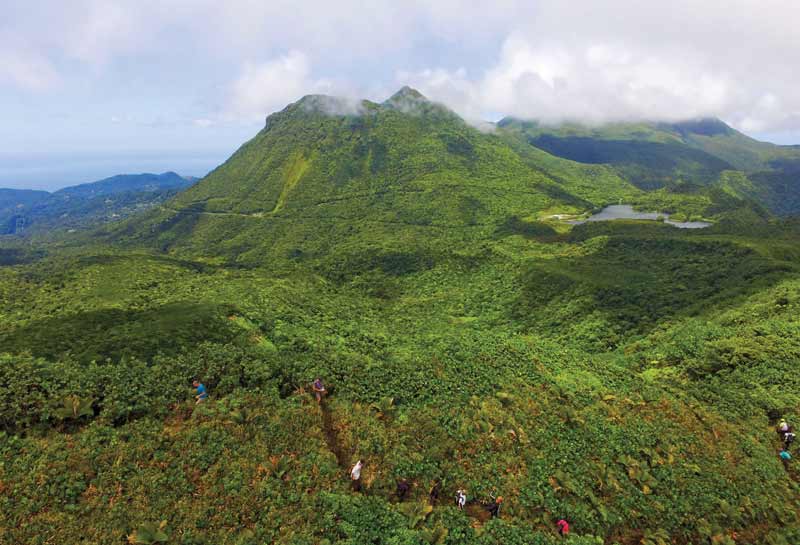
The Waitukubuli National Trail (the WNT) runs 114 miles (183 km) long.
Images Dominica Photo
Dominica was among the last of the Caribbean islands to be settled by Europeans, presumably because the local Carib people put up a fight. The Caribs, originally known (and still locally referred to) as the Kalinago people, are said to have migrated from South America by dugout canoe. Inhabitants since about 1,000 AD, they named the island “Waitukubuli” which means, “tall is her body” and no doubt refers to volcanic mountain peaks reaching more than 4,600 feet (1402 m) into the sky. Christopher Columbus must have been tired of coming up with new names for his discoveries by the time he claimed Dominica for Spain in November 1493. He called her Douménica — which means Sunday in Italian. This, after not even setting one foot ashore.
Descendants of the original Kalinago people reside in the Kalinago Territory on 3,700 acres (1,497 ha) of land on the island’s Northeast region. This is the only remaining settlement of indigenous people in all of the Caribbean. They have assimilated into local culture while also retaining their traditional culture, which can be experienced by visiting the village of Kalinago Barute Aute.
Spain wasn’t keen to develop Dominica, leaving it to the natives and various bands of pirates and privateers, but France and Britain squabbled over the island for centuries. Each country had their flags run up and down the flagpole several times as a result of one treaty or another. In the early 1800s coffee was a major export, but coffee exports declined following the abolishment of slavery in 1834. The island was left largely undisturbed. (In fact, a major tourist guidebook states that Dominica is the one island Columbus might actually recognize if he were to return to life and tour the Caribbean.)
In 1967 Dominica was granted Associated Statehood — virtual independence — with the United Kingdom handling its defense and external affairs. Full independence under a republican constitution came in 1978. The island’s economy is based on agriculture and tourism.
While the natural beauty of the island will amaze you, it’s the people who will truly inspire your Dominica holiday. Nestled in this natural splendor are some of the nicest people you’ll meet. Locals have a particular pride in their homeland and they delight in showing you around, sharing a piece of fresh fruit and a story or two.
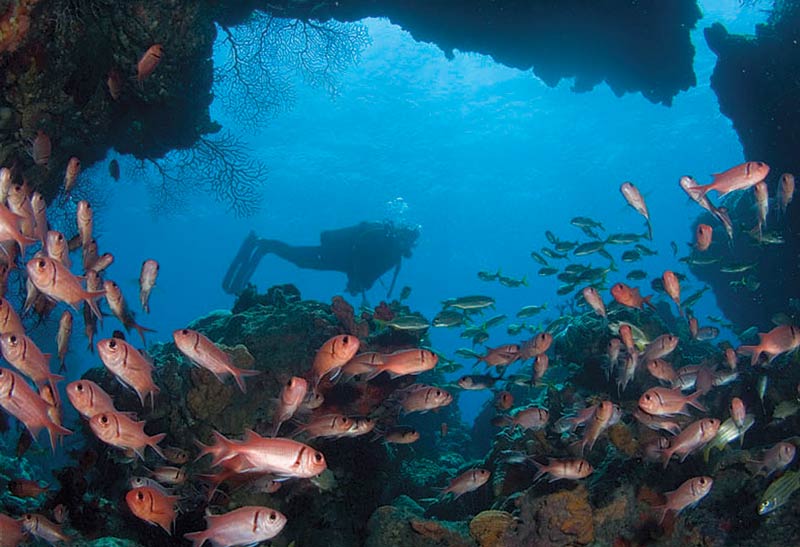
Dominica’s dramatic arches and swim-throughs will delight wide-angle photographers.
Images Dominica Photo
Diving in Dominica
With all the topside adventures to be had, it’s easy to imagine spending your entire visit just hiking and exploring on land. But don’t make that mistake, because what awaits you underwater is simply amazing. Imagine the dramatic topography of the volcanic interior, but put it underwater and add every color of the rainbow — plus schooling fishes and sea turtles. The backdrop of green mountains and lush valleys gives way to some of the most colorful, vibrant reefs, pinnacles and walls in the Caribbean. Most dives are in relatively shallow water, allowing for ample bottom time on each dive. And with underwater visibility consistently in the 80 foot (24 m) range and average water temperatures ranging from 78 to 84 degrees Fahrenheit (25 to 29 Celsius) you’ll want to spend as much time enjoying the marine life as possible. Some unusual and very satisfying diving can be done from shore but the majority of sites are reachable by boat.
The first thing most divers remark about are the sponges, which punctuate the reef with bright shocks of color. They’re everywhere. And they’re gigantic — especially the barrel sponges. Another remarkable thing about Dominica’s reefs is the fish life, which is prolific and diverse. Divers routinely swim with schooling French grunts, creole wrasse, silvery horse-eye jacks, southern sennets and the ever-present yellowtail snappers. The reefscapes are enough to thrill, but the keen-eyed macro lovers will lose their minds when they start spotting seahorses, frogfish, batfish, several shrimp species, varied crab species and lettuce sea slugs. Seasoned dive guides will help point these beauties out for you.
The wild east coast is unprotected from the Atlantic wind and swell, but on calm days there is some fantastic snorkeling to be enjoyed.
The leeward west coast faces the calmer Caribbean waters and is where most dive operators are located. The west coast can be divided into three diving regions: south, central and north. Each has its own unique feel.
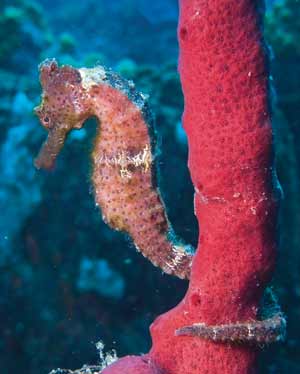
Keen-eyed divers are likely to find all sorts of rare treats, like this seahorse.
Images Dominica Photo
The southwest region of Dominica is where the famous Champagne reef dive is located, named for the tiny bubbles rising from the porous limestone seafloor, evidence of the island’s volcanic origins. This shallow site can be reached from shore and is perfect for snorkelers and divers. Be on the lookout for seahorses, frogfish and the bottom-dwelling flying gurnard. Off Pointe Guignard is an extensive reef system that starts shallow and runs into the abyss. Divers wishing to venture deeper will marvel at Danglebens Pinnacles, a series of five craggy underwater pinnacles that rise to within 35 feet (11 m) of the surface. Most of the dive is spent between 50 and 80 feet (15 and 24 m). There’s often a mild to moderate current here, meaning you’re likely to meet up with massive schools of jacks, barracuda and yellowtails. Scott’s Head Drop Off is another stunner, starting at 40 feet (12 m) and dropping off to 100 feet (30 m). Sponges, sponges and sponges dominate this dive, and the varied topography gives lobsters, shrimps, crabs and moray eels a lot of hiding spots. Heading north from Scott’s is Crater’s Edge, another volcanic ridge that attracts hoards of schooling fishes.
The Central Coast features underwater topography somewhat different from southernmost dive sites, in the form of fringing reefs with overhangs, tunnels and arches. Nose Reef and Whale Shark Reef are situated on the south drop-off of the Grand Savanne Flats. Here, ridged fringing reefs are covered in sponges and coral growth and are loaded with critters. Nearby Rina’s Hole is a shallow site noted for a swim-through that leads to a series of rock formations adorned with sea fans. A cave-like structure is stuffed with soldierfish and bigeyes. Critter hunters will enjoy Easy Street, a shallow dive that follows the contour of the coastline. At first glance it’s not much more than several piles of rocks, until you discover the abundance of marine life here that includes several shrimp species, crabs, moray eels and the occasional octopus.
Continuing northward, divers will be enthralled by Toucari Caves, which features swim-throughs that make great photo opportunities. Another unique dive is Pole to Pole, which gets its name from its location under a large jetty. This easy, shallow site offers plenty of small treasures to behold as you search the pilings. Just to the north of Cabrits is the wreck of a small inter-island ferry that sits upright and is covered in colorful marine life.
Dominica is known as a prime cetacean-watching destination. Species commonly seen here include several dolphin species, pilot whales and false killer whales. The island has a resident population of sperm whales that can be spotted cruising close to shore. Whale watching tours are very popular here and have become a “bucket list” adventure for many avid underwater photographers. The government is carefully controlling these activities in order to protect the whales and issue a limited number of permits allowing in-water viewing. If you’re lucky, you might be treated to a dolphin or whale sighting during a surface interval.
Getting Festive in Dominica
When you’re done diving and hiking, don’t expect to hit the mall or drive through a fast-food joint, because Dominica doesn’t have them. But do shop the small open-air markets for fresh fruit and locally made handicrafts. Explore the various beachside bars and restaurants to sample authentic Caribbean-creole cooking. Enjoy the local music.
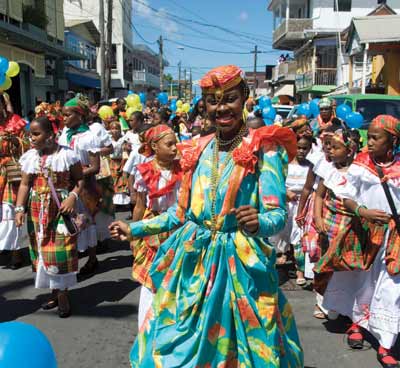
Dominicans know how to party. Festivals commemorating local culture, music and dance are celebrated throughout the year.
Images Dominica Photo
One thing Dominica does have a lot of is festivals. Mas Domnik is known as the “Real Mas” because it holds true to the traditional pre-Lenten Caribbean carnival celebrations of old. The official dates for 2018 are the 12th and 13th of February, with a full calendar of events taking place starting in early January.
The Dominica Festival of the Arts (DOMFESTA) runs April through June and showcases local music, theatre, art and dance. Other big festivals include Hikefest, typically held in May and Jazz Fringe running from the end of May to early June.
Now in its 24th year, Dominica’s Dive Fest takes place in July and is the longest running scuba diving festival in the Caribbean. It features snorkeling, diving and whale watching activities, canoe races, food and music. Learn more at dominicawatersports.com.
The annual World Creole Music Festival is held in late October and features “three nights of pulsating rhythms” that don’t stop until dawn. Expect to hear many different styles of music from reggae, to Kompa, Zouk, soukous and the local style called bouyoun that will have the locals in full dance mode.
Dominica gained full independence from the British Crown November 3, 1978. Dominican Independence Day is celebrated the Friday before November 3rd each year, with a variety of events. Locals take pride in wearing traditional costumes that celebrate their heritage.
A complete list of festivals, small and large, can be found at discoverdominica.com.
Restive and Restorative
Dominica’s tourism bureau describes its accommodations offerings with two words: “boutique and unique.” You can find everything from rustic backpacker hotels offering bare-bones amenities to eco-lodges artfully nestled into the natural surroundings, to luxurious oceanfront resorts with European-style spas and gourmet dining. There’s something to satisfy every taste and budget.
When you’re ready for a rest from diving and hiking and adventure touring, you can soak in one of the Nature Island’s sulphur-infused local hot springs or take a yoga class in a tropical rainforest setting. Several spas offer a full menu of massage and wellness treatments, too. Or just park yourself on a chaise lounge overlooking the water and enjoy the view.
You’ll leave Dominica relaxed, refreshed and ready to return again. Because to truly experience all the wonders this island holds, you’re going to need several visits.
By Jack Henderson

Dominica has 360 rivers and an abundance of dramatic waterfalls.
Images Dominica Photo

